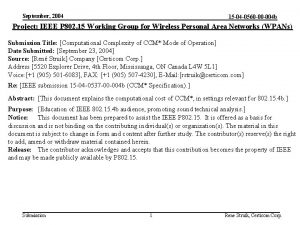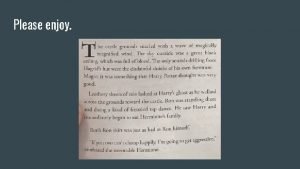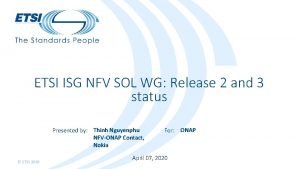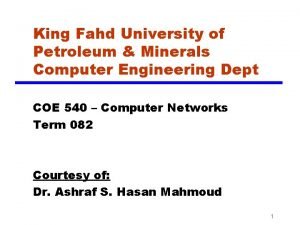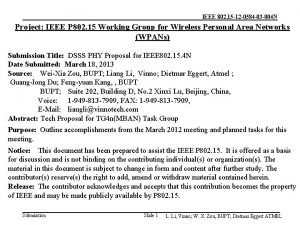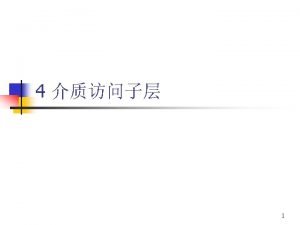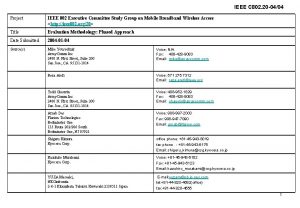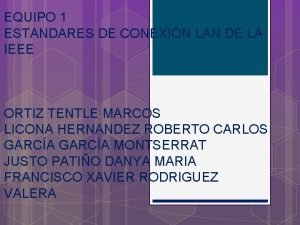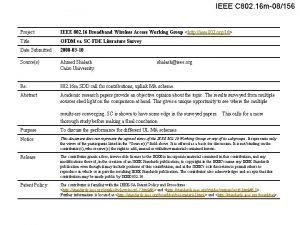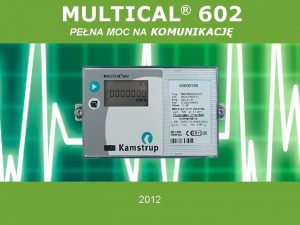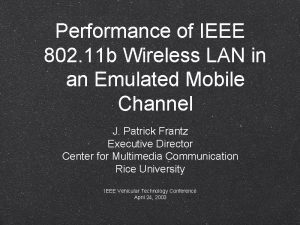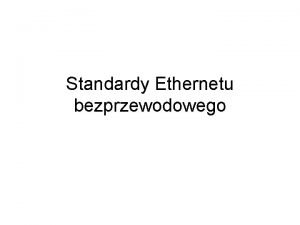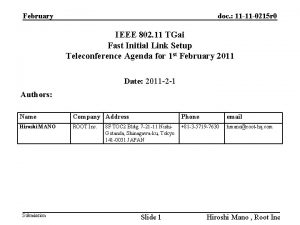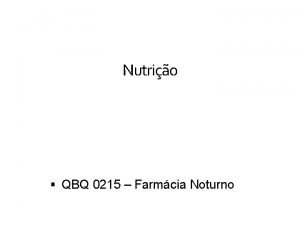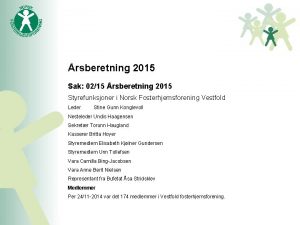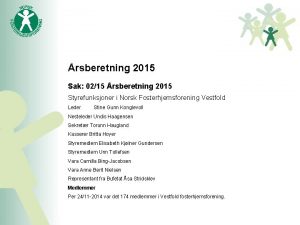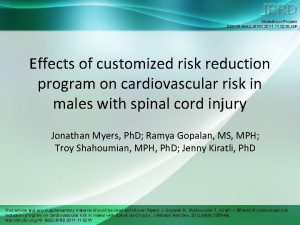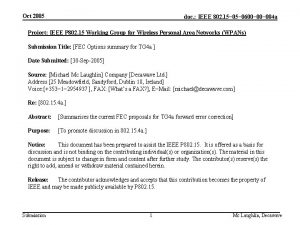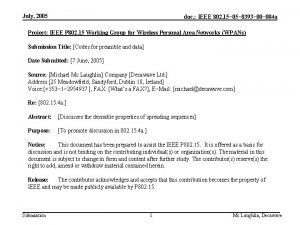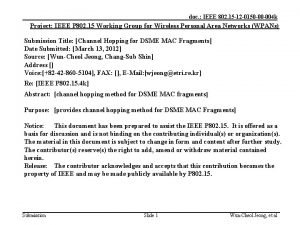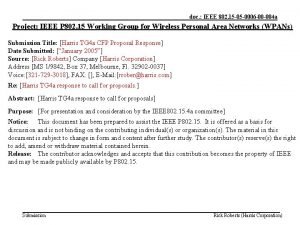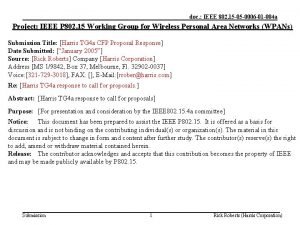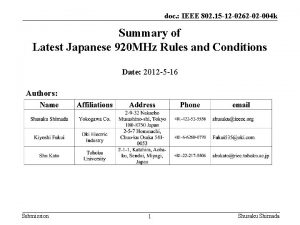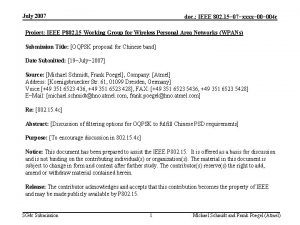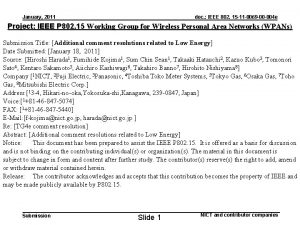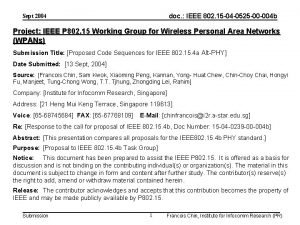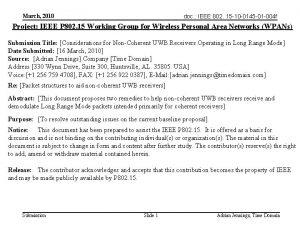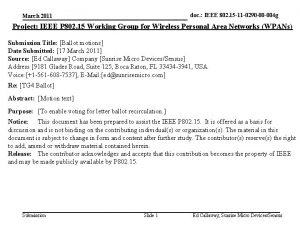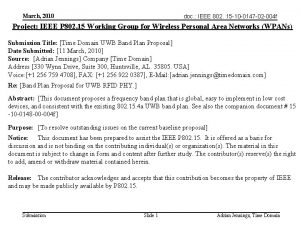doc IEEE 802 15 09 0215 00 004





























- Slides: 29

doc. : IEEE 802. 15 -09 -0215 -00 -004 e Project: IEEE P 802. 15 Working Group for Wireless Personal Area Networks (WPANs) Submission Title: [Channel Diversity Sub group Report] Date Submitted: [March 11, 2009] Source: [Wun-Cheol Jeong, Chol Su Kang, Kuor-Hsin Chang, José A. Gutierrez, Ludwig Winkel, Rick Enns, Myung Lee, Tae Rim Park, Betty Zhao, Ghulum Bhatti, Ning Gu, Jie Shen, Wei Hong, Qin Wang] Address [] Voice: [+82 -42 -860 -5104], FAX: [], E-Mail: [wjeong@etri. re. kr] Re: [IEEE P 802. 15. 4 e] Abstract: [This document is a report of channel diversity subgroup for IEEE 802. 15. 4 e. ] Purpose: [Discussion in 802. 15. 4 e Task Group] Notice: This document has been prepared to assist the IEEE P 802. 15. It is offered as a basis for discussion and is not binding on the contributing individual(s) or organization(s). The material in this document is subject to change in form and content after further study. The contributor(s) reserve(s) the right to add, amend or withdraw material contained herein. Release: The contributor acknowledges and accepts that this contribution becomes the property of IEEE and may be made publicly available by P 802. 15. Submission Slide 1 Channel Diversity

March, 2009 doc. : IEEE 802. 15 -09 -0215 -00 -004 e Channel Diversity Subgroup Report ETRI, Dust Networks, Freescale, Emerson, Siemens, CUNY, MERL, Huawei, Samsung, Arch Rock, SIMIT, Vino, USTB, SIA Submission Slide 2 Channel Diversity

March, 2009 doc. : IEEE 802. 15 -09 -0215 -00 -004 e Contributors • • • • ETRI: Wun-Cheol Jeong, Changsub Shin, Anseok Lee, Seong-Soon Joo Dust Networks: Chol Su Kang, Kris Pister (UC Berkeley) Freescale: Kuor-Hsin Chang, Clinton Powell Emerson: José A. Gutierrez Siemens: Ludwig Winkel Rick Enns: Consultant CUNY MERL Huawei Samsung Arch Rock SIMIT Vino USTB SIA Submission Slide 3 Channel Diversity

March, 2009 doc. : IEEE 802. 15 -09 -0215 -00 -004 e Table of Contents 1. Description of Channel Diversity 2. Anticipated Changes 3. Backward Compatibility Submission Slide 4 Channel Diversity

March, 2009 doc. : IEEE 802. 15 -09 -0215 -00 -004 e Description of Channel Diversity • Wireless channel introduces uncertainty due to the nature of wireless medium. • “Diversity” exploits channel variations due to channel fading and mutual interferences. – Diversity schemes in Frequency/Time/Spatial Domain Space PHY: Equalizer, OFDM, CDMA, Smart Antenna MAC: ARQ, Channel Diversity, Sector Ant. MAC NW; Path diversity Coherence Bandwidth frequency f time Submission Slide 5 Channel Diversity

March, 2009 doc. : IEEE 802. 15 -09 -0215 -00 -004 e Description of Channel Diversity • Channel Hopping – changing channel according to the predefined orthogonal (channel hopping) sequence. • Channel Adaptation – changing channel according to the channel quality measure such as CSI, packet error rate etc. Submission Slide 6 Channel Diversity

March, 2009 doc. : IEEE 802. 15 -09 -0215 -00 -004 e Channel Diversity • Mitigate Channel Impairments – Channel hopping/channel adaptation add frequency diversity to mitigate the effects of interference and multipath fading • If another network (like Wi. Fi) is busy in a band of 802. 15. 4 channels, retries outside of the band will work • The multipath coherence bandwidth ranges from 5 MHz for non. LOS to more than 20 MHz for near-LOS. A transmission on a faded channel can be retransmitted on other channels. • Improved coexistance • Increase Network Capacity – One timeslot can be used by multiple links at the same time by using different channels • Channel resources can be managed either in centralized or decentralized manner. Submission Slide 7 Channel Diversity

March, 2009 doc. : IEEE 802. 15 -09 -0215 -00 -004 e Channel Hopping 802. 15. 4 Channels Slot n-2 Slot n-1 Slot n+1 Slot n+2 11 12 13 14 15 16 17 18 19 20 21 22 23 24 25 26 • Proposals for Channel Diversity: – Distributed Channel Hopping (DCH) – Time Slotted Channel Hopping (TSCH) – Enhanced GTS (EGTS) Channel Adaptation Submission Slide 8 Channel Diversity

March, 2009 doc. : IEEE 802. 15 -09 -0215 -00 -004 e DCH: operation • Timeslot operation – Idle timeslot : No Tx and Rx – Rx timeslot • • • Tune to its own channel Enable receiver Receive data frame Turn to Tx mode Transmit Ack frame 0 2 – Tx timeslot • • Submission Jump to the receiver’s channel Transmit data frame Turn to Rx mode Receive Ack frame Slide 9 Channel Diversity

March, 2009 doc. : IEEE 802. 15 -09 -0215 -00 -004 e DCH: Offset Assignment • Empty offset selection - example – – – Submission node 1’s Neighbor offset bitmap = {1, 3, 6, 10} node 3’s Neighbor offset bitmap = {1, 3, 12, 13} node 6’s Neighbor offset bitmap = {1, 2, 6, 9} node 12’s Neighbor offset bitmap = {3, 12} Available offsets = {0, 4, 5, 7, 8, 11, 14, 15} Slide 10 Channel Diversity

March, 2009 doc. : IEEE 802. 15 -09 -0215 -00 -004 e DCH: Timeslot Allocation - sender A B C D Timeslot Request E D’s available timeslot : 1 0 0 1 1 1 Submission Slide 11 Channel Diversity

March, 2009 doc. : IEEE 802. 15 -09 -0215 -00 -004 e DCH: Timeslot Allocation - receiver A B C D Timeslot Response E D’s available timeslot : 1 0 0 1 1 1 E’s available timeslot : 0 1 1 0 0 1 1 1 1 Allocated timeslot : 0 0 0 0 1 1 0 0 0 Submission Slide 12 Channel Diversity

March, 2009 doc. : IEEE 802. 15 -09 -0215 -00 -004 e TSCH: Link = (Timeslot , Channel Offset) D One Slot Time Chan. offset A B A C D A B B A B C E F B E B F • The two links from B to A are dedicated • D and C share a link for transmitting to A • The shared link does not collide with the dedicated links Submission Slide 13 Channel Diversity

March, 2009 TSCH: Channel Hopping Time Channel Offset doc. : IEEE 802. 15 -09 -0215 -00 -004 e B A (ch 15) B A (ch 25) B A (ch 18) C A D A B A B C N*4+1 N*4+2 Cycle N • B A B C B E B F ASN= N*4 C A D A N*4+3 B C B E B F (N+1)*4 Cycle N+1 B E B F Cycle N+2 Each link rotates through k available channels over k cycles. – Ch # = Chan Hopping Seq. Table ( ( ASN + Channel Offset) % Number_of_Channels ) • Blacklisting can be defined globally and locally. (In Europe a frequency hopping system in the 2. 4 GHz band can blacklist only one channel, and adaptive blacklisting is not possible) Submission Slide 14 Channel Diversity

March, 2009 doc. : IEEE 802. 15 -09 -0215 -00 -004 e EGTS(adaptation): Allocation Rule • First, choose a time slot (or slots), which has at least one vacant channel. – – More than one slot can be allocated for each link (Tx & Rx pair). Don’t assign two channels at the same time slot to a device. See Fig. 1 Considering multi-hop delay (as discussed in the 15 -08 -0775 -01 -004 e). Considering time schedule: try to assign time slots next to time slots haven been assigned to themselves. See Fig. 2 time slots for A->B and B->C are successive Slots CH n CH m Slots A->B CH 1 CH 2 A->B B->C Fig. 2 efficient GTS allocation Fig. 1 conflicting GTS allocation • Then, choose a channel that is available in that time slot – Considering adjacent channel interference avoidance – Considering channel switch: try to avoid channel switch. See Fig. 2 channel for A->B and B ->C is the same Submission Slide 15 Channel Diversity

March, 2009 doc. : IEEE 802. 15 -09 -0215 -00 -004 e EGTS(adaptation): Allocation Bitmap Table (ABT) • Each node maintains a Neighborhood Allocation Bitmap Table (ABT) • Example (MO = SO = 3) • ABT size = 14 bytes • • 0: Vacant, 1: Allocated (self or neighbors) Row: time slot, Column: channel 00000000 01000100 000000001000 00000100 00000000 0100000000 Submission Slide 16 Channel Diversity

March, 2009 doc. : IEEE 802. 15 -09 -0215 -00 -004 e EGTS(adaptation): ABT sub-block… … • Entire bitmap may be too big to be transmitted by Beacon or EGTS command frames • Example (MO = 7, SO = 3) • ABT size = 224 bytes • • 0: Vacant, Row: time slot, 1: Allocated. Column: channel • Solution: • Send a ABT sub-block (with an index indicating beginning & ending of a block) • Example: 28 bytes sub-block. 000000001000 00000000 0100 00001000 00000000 10000000 0100 00001000 00000000 100000000 00000100 0000 0100000000 00000100 00000000 01000000 0100 00000100 0000 0100000000 00000000 … Submission Slide 17 Channel Diversity

March, 2009 doc. : IEEE 802. 15 -09 -0215 -00 -004 e EGTS: Three-way-handshake for Allocation • • Source Requesting destination Three command frames are transmitted during CAP period – EGTS request • • • – EGTS reply • • – Broadcast from the source Announce the assigned EGTS slots to all neighbors (28 bytes ABT sub-block) Schedule Update – • Broadcast from the destination. Select appropriate slots in the sub-block and announce the assigned EGTS slots to all neighbors (28 byte ABT sub-block). EGTS notify • • • Unicast from a source to a destination. Providing locally available slots (28 byte ABT sub-block). Required number of slots (depending on data rate). Those nodes who are reachable by EGTS Rep and EGTS Notify. Beacons do not carry EGTS allocation information – – Submission Entire EGTS bitmap may be too big. Periodically sending EGTS bitmap is energy consuming. Slide 18 Channel Diversity

March, 2009 doc. : IEEE 802. 15 -09 -0215 -00 -004 e EGTS(adaptation): Allocation Example Slot = tuple (time slot, channel) MO = SO Node 1 assigns slot (10, 15) for Node 3 2. EGTS reply, broadcast Payload : Dst addr (3) new allocated ABT sub-block {000000001000000 … 00000000 } Every node that hears the broadcasts updates its allocation bitmap table (ABT) 1. EGTS request, unicast Payload : Number of slots ABT sub-block {00000100000000 … 00000000 } 3. EGTS notify, broadcast Assuming slot (9, 21) is already assigned from node 4 for transmitting frames to node 3 Submission Slide 19 Payload : Dst addr (1) new allocated ABT sub-block {000000001000000 … 00000000 } Channel Diversity

March, 2009 doc. : IEEE 802. 15 -09 -0215 -00 -004 e EGTS: Duplicated Allocation Notification • Duplicated allocation can happen • Some nodes may miss some of EGTS reply or notify. (Broadcast is not reliable) • New joining node requests a slot not knowing the slot allocation state in the area. • Send EGTS collision notification during CAP period • The existing owner of the slot detects duplicated allocation by hearing neighbor’s EGTS reply or notify. • EGTS duplicated allocation notification (Unicast) from the existing owner. • Duplicated slot id (time slot, channel). • ABT sub-block (28 bytes) around the colliding time slot. • Forces the source and the destination nodes to retry three-way-handshake EGTS allocation. Submission Slide 20 Channel Diversity

March, 2009 doc. : IEEE 802. 15 -09 -0215 -00 -004 e EGTS: Deallocation & Expiration • EGTS Expiration ABT Table • • If an allocated EGTS is not used for longer than N beacon intervals, the allocation expires. Each destination device maintains a counter table for EGTS Expiration. • EGTS Deallocation • • Submission Slide 21 Deallocation also uses three-wayhandshake (request, reply, notify). Deallocation is performed • when a source device finds out EGTS expiration. • when a destination device does not need to use EGTS any longer. Channel Diversity

March, 2009 doc. : IEEE 802. 15 -09 -0215 -00 -004 e Anticipated Changes to Standard Submission Slide 22 Channel Diversity

March, 2009 doc. : IEEE 802. 15 -09 -0215 -00 -004 e MAC PIB Supporting Channel Hopping • DCH: – Channel Hopping Sequence – Channel Offset Value – Beacon Index – Allocation Bitmap Table • TSCH: – Default Channel Hopping Sequence – Channel Hopping Sequence Tables Submission Slide 23 Channel Diversity

March, 2009 doc. : IEEE 802. 15 -09 -0215 -00 -004 e TSCH MAC Primitives Supporting Channel Hopping • SET-SLOTFRAME Request parameters – slotframe size – channel page – channel map • SET-LINK Request parameters – Timeslot number – Channel offset Submission Slide 24 Channel Diversity

March, 2009 doc. : IEEE 802. 15 -09 -0215 -00 -004 e EGTS MAC Primitives and Commands Supporting Channel Diversity • A new parameter in a MAC Primitive – MLME-GTS. request (GTSCharacteristics, Security. Level, Key. Id. Mode, Key. Source, Key. Index, EGTSCharacteristics) – MLME-GTS. confirm (GTSCharacteristics, status, EGTSCharacteristics) – MLME-GTS. indication (Device. Address, GTSCharacteristics, Security. Level, Key. Id. Mode, Key. Source, Key. Index, EGTSCharacteristics) • A new command frame : EGTS Request – Sub-fields: MHR fields, Commands frame identifier, EGTSCharacteristics Submission Slide 25 Channel Diversity

March, 2009 doc. : IEEE 802. 15 -09 -0215 -00 -004 e Backward Compatibility Submission Slide 26 Channel Diversity

March, 2009 doc. : IEEE 802. 15 -09 -0215 -00 -004 e Backward Compatibility • Backward Compatibility is provided if the proposed protocol can coexist with legacy protocol. • No changes on the existing frame format • Only additions that are optional – New frame format, primitives, and PIB attributes • Two modes in 15. 4 -2006: Beacon enabled mode and non-beacon enabled mode Submission Slide 27 Channel Diversity

March, 2009 doc. : IEEE 802. 15 -09 -0215 -00 -004 e Factory Automation ISA, HCF Contention-Free TDMA E-GTS Zig. Bee, 802. 15. 5 Contention Access nonbeacon-enabled PAN Overhead Reduction/Security Low Energy Channel Diversity 802. 15. 4 Submission Slide 28 Channel Diversity

doc. : IEEE 802. 15 -09 -0215 -00 -004 e Sub-clauses for general description General Sub-clause type Channel diversity 5. 5. 4. x channel diversity new Submission Slide 29 Channel Diversity
 Alt+0215
Alt+0215 Bridges from 802.x to 802.y
Bridges from 802.x to 802.y Bridges from 802.x to 802.y
Bridges from 802.x to 802.y Ieee 802 standard
Ieee 802 standard Ieee 802 bluetooth
Ieee 802 bluetooth 802 ieee
802 ieee Ieee 802
Ieee 802 Ieee 802 family
Ieee 802 family Ieee 802 3 compliance
Ieee 802 3 compliance Wlan standards
Wlan standards Arquitetura ieee 802
Arquitetura ieee 802 Modelo ieee 802
Modelo ieee 802 Auec2-001
Auec2-001 0560 004
0560 004 700 004
700 004 Wärmetönungssensor
Wärmetönungssensor Croix de saint andré charpente métallique
Croix de saint andré charpente métallique Sol 003
Sol 003 Pyp 004 kfupm
Pyp 004 kfupm Team-004
Team-004 802 15
802 15 Bus topology
Bus topology 802 20
802 20 Estandares 802
Estandares 802 802 16
802 16 802 16
802 16 Komunikacj
Komunikacj Geo 802
Geo 802 802 11 b
802 11 b Standardy 802
Standardy 802













